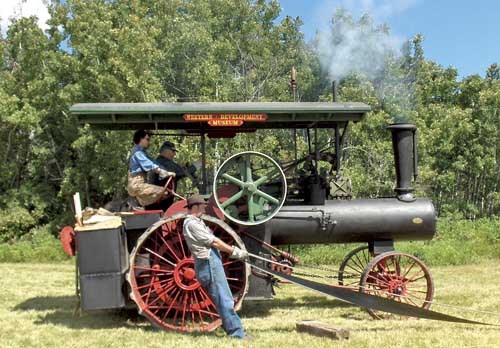It all began during the mid 1940s when the drive to collect scrap metal for Second World War munitions threatened the survival of unused agricultural equipment - the steam engines, gas tractors, and plows - that had turned prairie sod into furrowed fields. A group of history-minded people in the Battlefords banded together, determined to save some of this agricultural heritage before it was lost forever.
On April 2, 1949, the fledgling museum was given legal status with the passage of the Western Development Museum Act. The WDM was mandated to collect, preserve and exhibit artifacts representing the economic and cultural development of Western Canada. Museum officials scoured the province for artifacts as the vision expanded to include household and business furnishings, clothing and textiles and a host of other items.
Beginning in the mid-1950s, pioneer shows flourished as staff and volunteers returned machinery to operating condition. The WDM celebrated the province's Golden Jubilee in 1955 with a lively presentation of men, horses and machines in action. The puffing steam engines and chugging gas tractors that came to life back then continue to this day with Pion-Era at Saskatoon, Those Were the Days at North Battleford and the Threshermen's Show and Seniors' Festival at Yorkton. The Moose Jaw WDM hosts the only operating steam locomotive in Saskatchewan. The shows have evolved to include activities for all ages and women play a strong part in organizing the events. A few operate equipment.
Museums on the Move
Crowded hangars spurred change during the 1960s and 1970s. The WDM in North Battleford moved from the airport to a new site at the junction of Highways 16 and 40 and construction of an outdoor pioneer village took shape.
In 1972 the Saskatoon WDM moved to a new building near the Exhibition grounds and the Yorkton WDM relocated to a site on the Yellowhead highway. In all three cities the old hangars were retained for storage. A new WDM, the History of Transportation, opened at Moose Jaw in 1976.
During the 1980s, hundreds of artifacts were transferred from the old hangars to a renovated warehouse, to be known as the Curatorial Centre, near the Saskatoon WDM.
To celebrate Saskatchewan's centennial, dynamic new interactive exhibits titled Winning the Prairie Gamble were created in each of the four WDMs with staged openings beginning in 2005. New programs, new events, and travelling exhibits continue to attract visitors to all four WDMs..
Artifacts and their stories help us to understand our past, enhancing our understanding of the present. They evoke much more than nostalgia for the 'good old days.' They inspire an appreciation of coping with hard times, of how we lived without today's technology. Times of poverty and times of plenty have fostered a spirit of innovation as Saskatchewan people worked to get ahead. This can-do attitude is reflected in WDM collections and exhibits. As one might expect from a province steeped in agriculture, many innovative ideas were hatched in farm shops; rod weeders and discers, grain augers and field packers to name a few.
The WDM's Norseman airplane CF-SAM represents Saskatchewan's pioneering air ambulance service begun in 1946. The cobalt-60 unit built at the University of Saskatchewan in 1951 changed cancer treatment both here in Saskatchewan and around the world. The ATM and the debit card pioneered in Canada by Saskatchewan credit unions revolutionized banking.
The WDM collection contains many other artifacts that reflect resourceful Saskatchewan people. Take the Hawarden farm wife who filled her quilt with wool plucked off a neighbour's barbed wire fence. Or the blacksmith from Tisdale who forged his own artificial limb after losing an arm in a railway accident. There's the entrepreneur from Rocanville who designed a better oil can and built a business that endured for nearly 50 years. More recently, there's the PapaBravo Innovations Gofer, an electric vehicle developed in Saskatoon for use in underground potash mines.
"While honouring Saskatchewan's pioneer roots, the WDM is committed to collecting artifacts that represent the province's more recent history." said Joan Champ, WDM Executive Director. "As the Museum moves forward, collecting artifacts that represent post-1950s stories and showcase our many achievements will be a priority."




